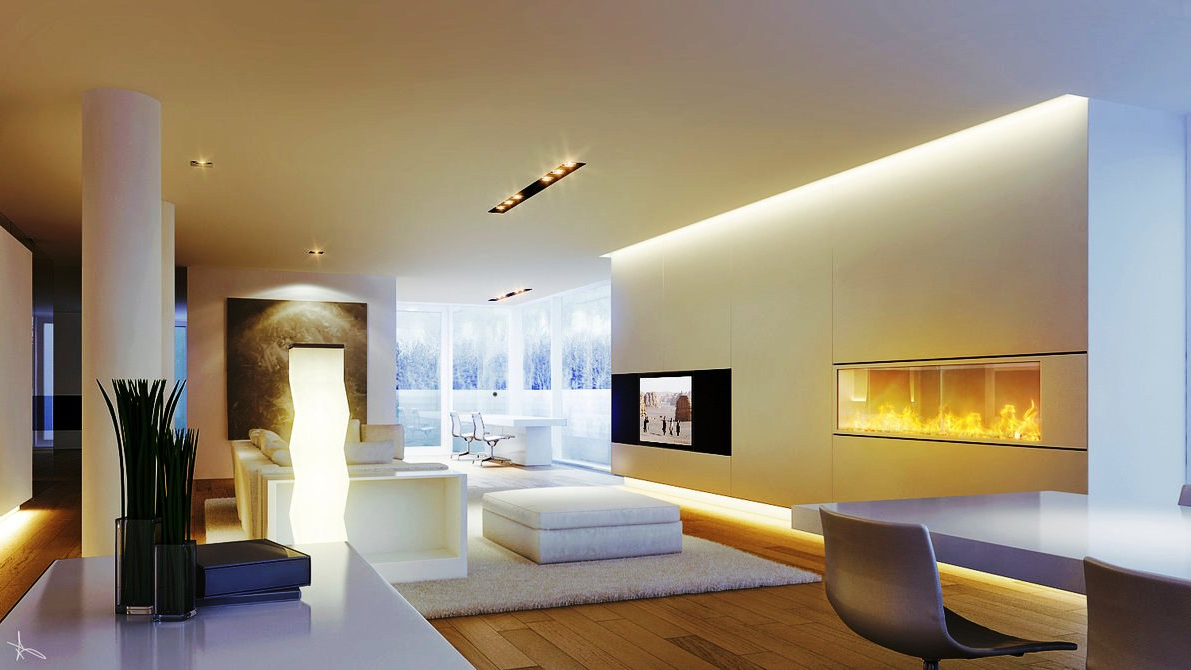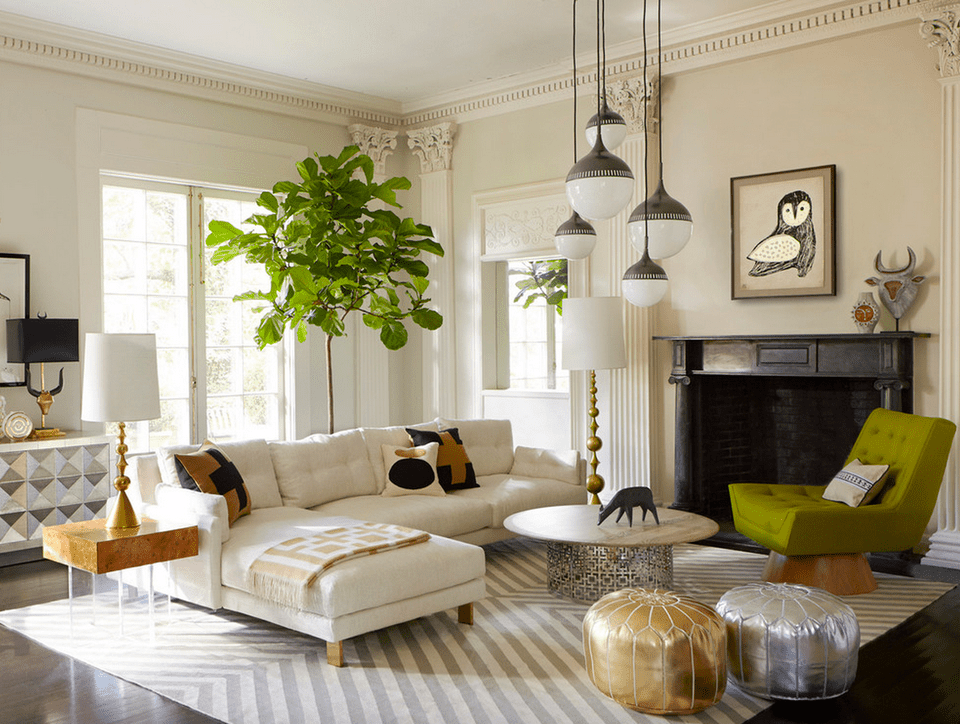The right lighting can make all the difference between a cold, flat room and one that feels like home. It’s not just about turning lights on and off – it’s about creating layers of light that tell a story, guide the eye, and wrap your space in warmth. Think of lighting as the invisible architect of your living room’s atmosphere. Every lamp, every fixture, every glow adds a new dimension to your space. This isn’t about expensive fixtures or complicated setups. It’s about understanding how different types of light work together to create something magical.
Have you ever walked into a room and instantly felt comfortable? Maybe it was the way the morning sun streamed through the windows, or how the soft glow of table lamps made everything feel cozy. That feeling comes from good lighting design. It’s not just about brightness – it’s about creating a sense of depth and warmth that makes a space feel lived-in and welcoming. When you think about it, lighting does much more than illuminate your furniture. It shapes the mood, defines areas, and tells the story of your home. The secret lies in layering different kinds of light sources. This approach creates a rich, multi-dimensional experience that changes with the time of day and your activities. Whether you’re entertaining guests or curling up with a book, proper lighting can make every moment better.
Understanding the Three Lighting Layers
Creating depth and warmth starts with knowing the three basic lighting layers. The first is ambient lighting – the general illumination that fills the whole room. Think of it as the foundation. It’s usually provided by overhead fixtures or ceiling lights. The second layer is task lighting – focused light for specific activities like reading or working. This might be a floor lamp beside your chair or a desk lamp. The third and most important layer is accent lighting – the dramatic, decorative light that highlights features and creates visual interest. It could be a spotlight on a piece of art or a string of lights around a mantel. These layers work together like a symphony. Without any one of them, the room feels incomplete. The magic happens when they blend seamlessly. A well-designed layered lighting scheme means your room adapts to different moods and times of day. You can dim the ambient light for dinner, turn up the task lighting for reading, and add accent lighting to showcase your favorite items. This flexibility transforms a simple living space into a dynamic environment.
Ambient Lighting: The Foundation of Room Atmosphere
Ambient lighting is the backbone of any good lighting plan. It provides the basic illumination that allows you to move around safely and comfortably. The key is choosing fixtures that offer even, diffused light rather than harsh glare. Recessed ceiling lights work well for this purpose, but don’t overlook the power of a beautiful chandelier or a simple pendant light. The size and placement matter enormously. A large room needs more fixtures spread across the ceiling, while a smaller space might need just one statement piece. Consider dimmer switches for ambient lighting – they give you control over the overall mood. Imagine having your living room bathed in bright daylight during the afternoon, then softly glowing as evening approaches. That’s the beauty of ambient lighting with dimming capability. It’s the first thing people notice when they enter a room, so make it welcoming. You want it to feel bright enough for daily activities but soft enough to avoid eye strain. A good rule of thumb is to aim for 10-15 lumens per square foot for general room lighting. This ensures adequate illumination without being overwhelming.
Task Lighting: Functional Glow for Daily Activities
Task lighting is where you’ll find yourself spending most of your time in the living room. Whether you’re reading a book, working on a laptop, or crafting something creative, you need focused light. The best task lighting is adjustable and positioned to avoid shadows on your work surface. Table lamps are excellent for this purpose, especially those with flexible necks or adjustable arms. Floor lamps can also serve as task lights, particularly if they’re positioned near seating areas where you spend time reading. Consider the height and angle of your task lights carefully. They should provide direct illumination without creating uncomfortable glare. A common mistake is placing task lighting too low or too high. The ideal position is typically 36 inches above the surface you’re working on. This prevents shadows and reduces eye fatigue. You might also consider adding a reading lamp next to your favorite chair. This small investment pays dividends in comfort and convenience. The right task lighting can reduce eye strain and make your living room more functional. It’s about making life easier, not just prettier.
Accent Lighting: Adding Visual Interest and Drama
This is where your living room really comes alive. Accent lighting draws attention to specific features and creates focal points that make the space memorable. It’s the lighting that makes a painting pop, highlights architectural details, or creates a cozy corner for conversation. Track lighting is excellent for this, allowing you to direct light exactly where you want it. Picture lights, which mount behind frames, can make artwork appear to float. String lights, whether wrapped around a bookshelf or draped across a wall, add a whimsical touch. The key to successful accent lighting is subtlety. You don’t want it to compete with the ambient light – instead, it should enhance and complement it. Think about what elements in your room you want to highlight. Is it a beautiful fireplace, a collection of books, or perhaps a striking piece of furniture? Once you know what you want to showcase, you can choose the right type of accent lighting. The interplay between ambient and accent creates depth. The ambient light illuminates everything evenly, while the accent lighting adds drama and dimension. This contrast is what makes a room feel alive and interesting.
Warm vs Cool Light Temperature: Choosing the Right Mood
Light temperature is one of the most powerful tools in your lighting arsenal. It’s measured in kelvin (K) units, with lower numbers producing warm, yellowish light and higher numbers creating cool, bluish light. For living rooms, you generally want warmer temperatures – between 2700K and 3000K. This creates a cozy, inviting atmosphere that’s perfect for relaxation and socializing. Imagine sitting in a dimly lit room with warm lighting – it instantly feels more comfortable than a bright, cool-lit space. The warmth in lighting affects our emotions and behavior. It’s why restaurants often use warm lighting to encourage diners to stay longer. In your living room, warm lighting helps you unwind after a long day. You can still have cooler lighting in areas where you need to focus, like a home office or dining area. But the main living spaces benefit from that golden glow. Some modern LED bulbs allow you to adjust color temperature, giving you the flexibility to change the mood throughout the day. Morning might call for brighter, cooler light to help you wake up, while evening can be all about the warm, intimate glow. It’s a simple change that makes a huge difference in how your space feels.
Practical Tips for Implementing Layered Lighting
Putting these concepts into practice doesn’t require a complete renovation. Start by assessing your existing lighting setup. What’s missing? What could be improved? Sometimes it’s as simple as adding a table lamp or swapping out a harsh overhead bulb for a softer one. Here are some practical steps to get started:
• Add one new light source at a time to avoid overwhelming your space.
• Choose fixtures that complement your existing style rather than clashing with it.
• Use dimmer switches to create different atmospheres throughout the day.
• Place task lighting within arm’s reach of frequently used areas.
• Consider smart lighting options that can be controlled via smartphone apps.
Don’t forget to test your lighting at different times of day. Natural light changes throughout the day, affecting how artificial lighting looks. What looks great in the morning might seem too dim or too bright in the evening. The goal is consistency – your room should feel comfortable regardless of when you’re using it. Pay attention to how light falls on your walls, furniture, and surfaces. Good lighting creates shadows that add depth. Poor lighting flattens everything out. Take time to adjust your fixtures until you find the right balance. Sometimes a simple repositioning of a lamp can dramatically change the look and feel of a room.
Final Thoughts on Creating Your Perfect Lighting Scheme
The best lighting schemes are those that feel effortless and natural. They support your lifestyle and enhance your space without drawing attention to themselves. When you’ve got the right layers of light, your living room becomes a place where you actually want to spend time. It’s not just about looking good – it’s about feeling good. The warmth and depth created through thoughtful lighting choices can transform a house into a home. Remember, there’s no one-size-fits-all solution. Every room is different, and every person has different preferences. The key is experimentation. Try different combinations, adjust levels, and see what works for you. Don’t be afraid to make changes. Good lighting is an investment in your daily happiness. It’s one of those things that people notice without necessarily knowing why – they just feel more comfortable and relaxed in a well-lit space. So take your time, play with different ideas, and trust your instincts. Your living room deserves to be a place where light and warmth come together beautifully.
Creating depth and warmth in your living room through lighting layering is both an art and a science. It’s about understanding how different types of light interact and how they affect your mood and daily routine. When done right, lighting transforms your space from merely functional to truly welcoming. The three layers – ambient, task, and accent – work together to create a rich, multi-dimensional environment that adapts to your needs. Warm light temperatures add that crucial element of comfort, while careful placement and dimming capabilities give you control over the atmosphere. You don’t need expensive fixtures or professional installation to achieve these effects. Simple changes like adding a table lamp or switching to warmer bulbs can make a world of difference. The real magic happens when you start thinking about lighting not as a single source, but as a conversation between multiple elements. It’s about creating a visual story that unfolds as you move through your space. Whether you’re hosting friends or relaxing alone, the right lighting makes every moment better. This is ultimately about making your home a place where you want to be – and that starts with how the light falls on your walls and furniture. The journey to perfect lighting is ongoing, but each small improvement brings you closer to that ideal cozy atmosphere you’ve always dreamed of.















